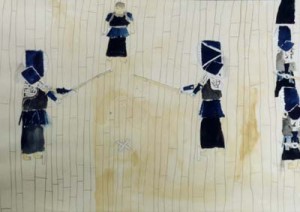Submitted by Seiko Sigmund, Center for Global Studies, Norwalk, CT USA
Theme: As is the case with many countries, Japan has a unique set of traditions. Traditions are defined as “an inherited, established or customary patterns of thought, action or behavior.”
Overview: This activity invites students to explore interesting aspects of Japanese culture and a few Japanese traditions.
Target Audience: 9-12 grade students
Time required: 45 minutes
Preparation: Ensure that your students have access to this website or print out copies of the following 4 artworks included here: First Visit to The Year to the Shrine, Tanabata Festival, Boy’s Festival, and The Game of “Kendo”.
Procedure:
1. Divide class into groups and assign a different piece of art to each group.
2. If each group doesn’t have access to a computer, print out the art and artist descriptions, and hand one set to each group. Also, if necessary, copy, print, and hand out the appropriate questions for each piece.
3. Students examine and discuss each picture and then answer the following:
- Observation Questions: These questions are based solely on their observation of the art and artist’s descriptions.
- WebQuest Questions: Students answer these after viewing the recommended web links.
- Critical Thinking Questions: Students use higher ranking thinking skills to answer these questions.
4. Allow 5 minutes per group (20 minutes in all for 4 groups) to display their assigned art piece, present their discoveries and insights and lead a short discussion.
5. End with a brief discussion of what the students have learned about Japan and the importance of tradition in Japanese culture.
6. Suggested additional activity, if time allows: Re-enactment: group members form a “tableau” with each member selecting one person in the scene. Copy their body position, facial expression, etc. and freeze. At the signal, each participant unfreezes and all group members interact and act out in action and dialogue what might happen next.
 First Visit of the Year to the Shrine, Artist: Mariha I. from Tokyo, Japan
First Visit of the Year to the Shrine, Artist: Mariha I. from Tokyo, Japan
- Observation questions: Look closely at the details in the art, read the artist description, and answer these questions:
a) Visiting a shrine on _______________ is one of the typical Japanese customs.
b) What do they give to the shrine?
c) What are they wearing?
- Web Quest questions: Open up the suggested link to find the information needed to answer these questions:
a) Temples in Japan strike ___________ times on the eve of the New Year. Why?
b) Why is the New Year’s holiday so important to the Japanese?
c) What do the visitors do at the shrine on New Year’s Day?
- Critical Thinking Questions:
a) Is there a special place where you can make your wish in your culture?
b) What is your wish?
c) Why are traditional days/holidays so important to different cultures?
- Re-Enactment: (Time permitting)Create a frozen picture (or tableau) by each of you taking the posture of one of the people in the scene. Try and imagine what your character might be feeling and thinking. Once frozen, at the count of 3, unfreeze and carry out what might happen next by moving and speaking. End the scene after about a minute.

“Tanabata” Festival, Artist: Takahisa T. from Hokkaido, Japan
- Observation questions: Look closely at the details in the art, read the artist description, and answer these questions:
a) What’s on the tags that are hanging from the tree?
b) When is the “Tanabata” festival?
c) What do they do with the tree after the festival? Why do they do that?
- Web Quest questions: Open up the suggested link to find the information needed to answer these questions:
a) “Tanabata Festival” is originally from ____________.
b) What is the legend of Tanabata?
c) Which main characters are there in the “Tanabata” story?Website: http://web-japan.org/kidsweb/folk/tanabata/index.html
- Critical Thinking Questions:
a) Does this festival remind you of any festivals or traditions you celebrate in your culture?
b) What other cultures use smoke to send a message to their deities?
- Re-Enactment: (Time permitting)Create a frozen picture (or tableau) by each of you taking the posture of one of the people in the scene. Try and imagine what your character might be feeling and thinking. Once frozen, at the count of 3, unfreeze and carry out what might happen next by moving and speaking. End the scene after about a minute.

The Boy’s Festival (currently called Children’s Festival) Artist: Syou M. from Hiroshima, Japan
- Observation questions: Look closely at the details in the art, read the artist description, and answer these questions:
a) When is the Boy’s Festival?
b) What kind of fish do you see in the picture?
c) What do the Japanese celebrate on the day? How do they do it?
- Web Quest Questions: Open up the suggested link to find the information needed to answer these questions:
a) What is the Japanese wording for “Children’s Day”?
b) A carp is a symbol of ______________________________________.
c) Do children use this day to thank and show respect for their teachers, parents, and relatives?Website: http://kids.asiasociety.org/explore/childrens-day-japan-kodomo-no-hi
- Critical Thinking Questions:
a) Do you have a similar symbol to represent health and/or strength in your culture or country?
b) Do you think every culture should have a “Children’s Day” festival?
- Re-Enactment: (Time permitting)Create a frozen picture (or tableau) by each of you taking the posture of one of the people in the scene. Try and imagine what your character might be feeling and thinking. Once frozen, at the count of 3, unfreeze and carry out what might happen next by moving and speaking. End the scene after about a minute.
 The Game of “Kendo”, Artist: Tomoki O. from Tokyo, Japan
The Game of “Kendo”, Artist: Tomoki O. from Tokyo, Japan
- Observation questions: Look closely at the details in the art, read the artist description, and answer these questions:
a) Kendo is the art of____________?
b) It is derived from sword fighting techniques practiced by ____________warriors 1000 years ago.
c) What is required to play Kendo well?
- Web Quest Questions: Open up the suggested links to find the information needed to answer these questions:
a) Instead of a metal sward, in Kendo, ________________ is used.
b) What does this sport remind you of?
c) How important is speed and timing in this sport?
- Critical Thinking Questions:
a) How important is competition in your culture?
b) Should Kendo be one of the Olympic Games?
- Re-Enactment: (Time permitting)Create a frozen picture (or tableau) by each of you taking the posture of one of the people in the scene. Try and imagine what your character might be feeling and thinking. Once frozen, at the count of 3, unfreeze and carry out what might happen next by moving and speaking. End the scene after about a minute.

